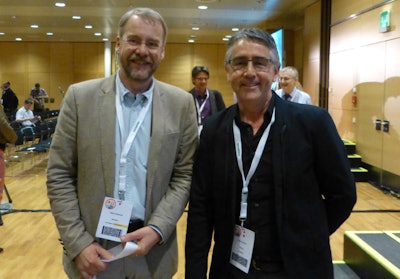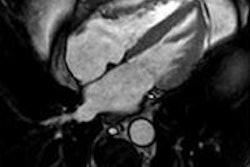
Is the strong focus on radiation protection and safety hampering the introduction of new radiotherapy technologies and treatment strategies? That was the question under discussion during a lively debate at the recent European Society for Radiotherapy & Oncology meeting (ESTRO 33) in Vienna, Austria.
The session examined whether too cautious an approach to safety issues has slowed the implementation of advanced radiotherapy techniques such as intensity-modulated radiotherapy (IMRT) into wider clinical practice, thereby delaying the rollout of potential benefits to patients. Speaking for the motion was Håkan Nyström, PhD, chief physicist at the Skandion Clinic in Sweden, while Robin Garcia, PhD, physicist and head of department at Institut Sainte Catherine in France, presented the case against.
 Håkan Nyström, PhD, and Robin Garcia, PhD.
Håkan Nyström, PhD, and Robin Garcia, PhD.A show-of-hands vote taken at the start of the session revealed that the majority of the assembled delegates disagreed with the proposed motion. Nyström spoke first, tasked with convincing the audience otherwise.
He described how radiotherapy has always been technology-driven, with constant developments over the decades improving outcomes for millions of cancer patients. But while advances in treatment delivery offer the potential to reduce errors, they may also introduce new types of errors. Thus, the introduction of new techniques and modalities must be performed with caution.
Nyström cited a study examining the introduction of IMRT and comparing reported delivery errors (deviations from the intended treatment) with those seen for the less complex techniques of 3D conformal and conventional radiotherapy. The study found 155 errors in radiotherapy delivery among 241,546 fractions, with different types of error seen for the different modalities. Interestingly, IMRT was associated with the lowest error rate of the three.
"This is 155 errors too many," he said. "But errors happen, and considering that they were looking at a quarter of a million fractions, we could say that they only found 155 errors. In addition, none of these were clinically significant. Radiotherapy is a safe procedure."
Though IMRT was introduced over a decade ago, uptake has been slower than ideal, with some cancer centers still not implementing this advanced technique even today. "A lot of patients who could have benefited from IMRT don't get it, because it took time to introduce," Nyström said. So why was there a gap of some 10 years between early and late implementation of IMRT?
Nyström attributes the delay to issues surrounding safety and the public's sensitivity regarding the use of ionizing radiation. He gave some examples of recent media coverage heavily publicizing radiotherapy accidents, as well as TV reports inflating the risks of radiation and further increasing public anxiety.
He compared the situation to that in the aviation industry, where many people are scared of flying and think it is dangerous, whereas in reality -- just like radiotherapy -- flying is safe. "The reason for being afraid to fly is not rational, it's emotional," he said. "There is a high risk for cancer patients -- the main risk is not being cured. The second risk is being harmed by the side effects of treatment."
Nyström emphasized that poorly supported information misrepresenting radiation risks must not be allowed to prevent medical physicists from continuing to optimize radiotherapy modalities. "Maybe the most important mission that we have as medical physicists is the introduction of new technology," he said. "Of course it should be safe, but never forget that we need new technologies to increase the probability of cure and reduce side effects."
Such research must then be transferred into the clinic as efficiently as possible. This requires equally strong emphasis on all the key steps: cutting-edge research, translational research, technology improvement, and clinical implementation.
"If you're afraid of flying, stay at home or take the train. If you're afraid of radiation, fine, avoid exposure. But if you are a cancer patient in need of radiotherapy, you don't have as many options -- you should be offered the best treatment using the best modalities that we can offer," Nyström concluded.
The case against
Next to take the stage, Garcia began by discussing exactly what is involved in the introduction of a new radiotherapy technique, emphasizing that it's "not just about installation." The process is a long chain: the equipment is chosen; installation and commissioning takes place, followed by testing and quality assurance; procedures must be established and staff trained; and finally, treatments can begin, with ongoing assessment of results.
One of the key links in this chain is the training process. Medical physicists are tasked with supporting the technical implementation of new treatment techniques. But with rapid technology evolution, and increasing system and software complexity, it's vital that users become experts before a new technology is used on patients. This could be achieved via transfer of experience from colleagues, industry training, knowledge transfer from existing specialists, or training workshops.
Economic constraints, however, can impede the availability of such training, leaving physicists and clinicians to work on new equipment without sufficient expertise. Garcia described a discussion that he had with a colleague at a small treatment centre that was installing a new system. The colleague requested a workshop to learn how to use the device, but his boss replied that there was no money available, and he'd just have to be taught by the vendor.
Insufficient training, however, along with other examples of "nonsafety" such as unsuitable measurement equipment, lack of human resources and machine access, and no external help, can result in serious accidents.
Garcia presented a stark example of a recent incident in France in which lack of resources, equipment, and competences led to many patient injuries and several fatalities six years ago. In this case, incorrect calibration during installation of new radiotherapy machines, insufficient training of technicians in use of the new systems, as well as errors in dose calculations led to patients receiving radiation overdoses.
In an ensuing court case, two doctors and a physicist were given prison terms. Garcia noted that the hospital administrators were acquitted of any charges against them. "I agree with need for new technology, but at the same time, I have a colleague who will go to jail," he said.
He concluded by emphasizing that the continual introduction of new technologies will increase the risks -- for patients but also for the physicists. The only safe option is to obtain sufficient resources such that insertion of new technologies can be performed everywhere with higher quality and greater safety.
"Safety improves the introduction of new technologies," Garcia concluded. "Every time that we introduce a new technology, we should start with a safety phase."
Audience opinion
The debate was then thrown open to the audience. Pedro Andreo from Stockholm University in Sweden agreed that people are overly afraid of x-rays, but pointed out that there is proof that new technology can be harmful and result in radiotherapy accidents. "I can't believe that safety is delaying the introduction of new technologies, that's like saying traffic rules are hampering the traffic," he said. "If you introduce a new technique and have no idea of the potential consequences, you have to be sure that the patient won't be harmed."
Philip Mayles from the U.K.'s Clatterbridge Cancer Centre pointed out that older technologies are not necessarily safer than newer approaches. "If you ask whether RapidArc is more dangerous that using wedges [to modify the beam], I can think of two examples of accidents with wedges," he said.
"You can never make a process totally fail-proof," added Dirk Verellen from Vrije Universiteit Brussel in Belgium. "Yes we need safety, but at some point you must decide how much risk you are willing to take."
 Show of hands.
Show of hands.The session concluded with a second show-of-hands vote. As with the previous vote, the majority of attendees disagreed with the motion -- believing that safety issues do not necessarily hamper the introduction of new technologies. It seems for this audience at least, it's a case of "safety first" when it comes to radiotherapy evolution.
© IOP Publishing Limited. Republished with permission from medicalphysicsweb, a community website covering fundamental research and emerging technologies in medical imaging and radiation therapy.




















